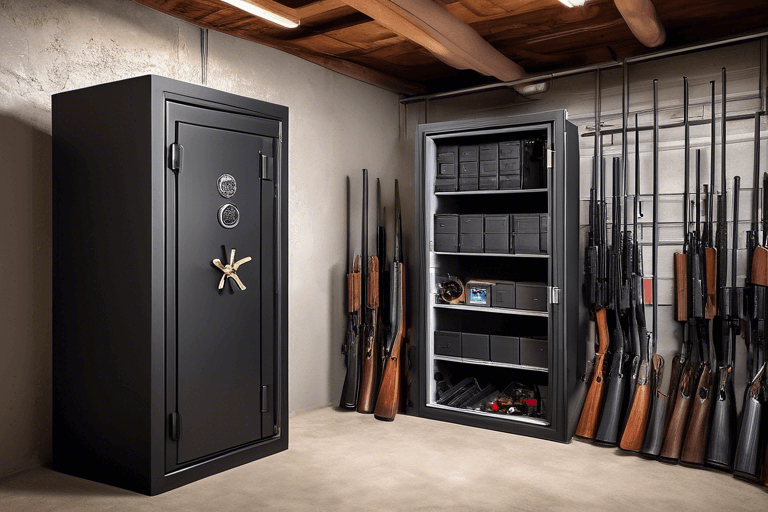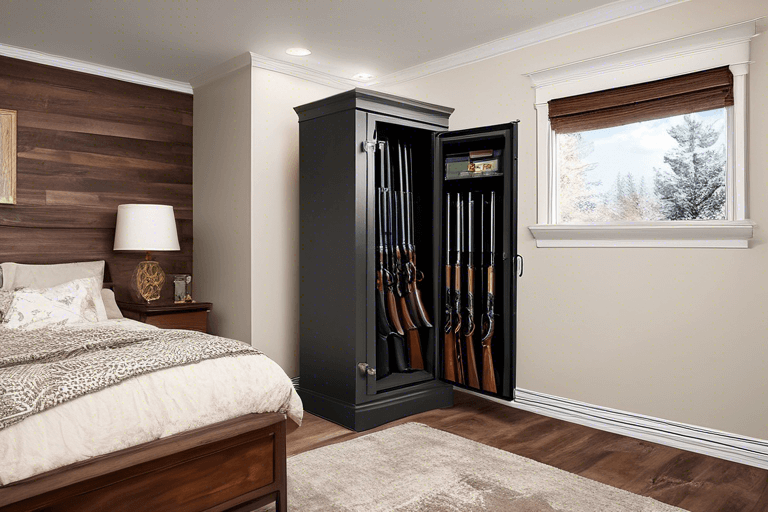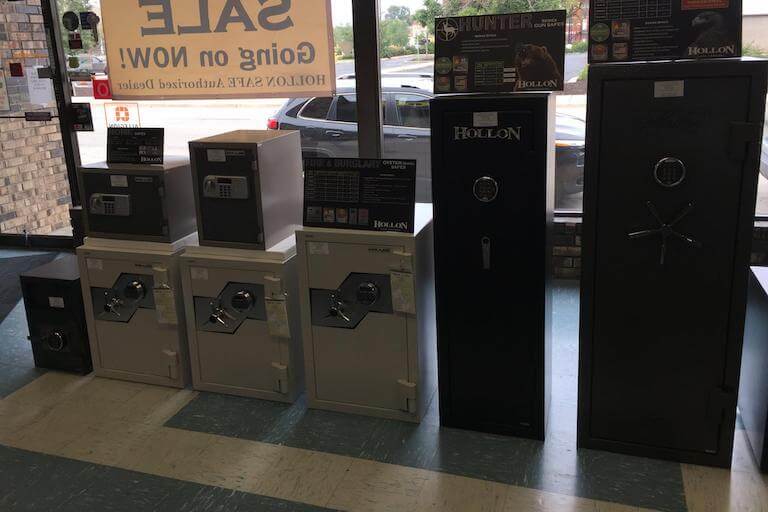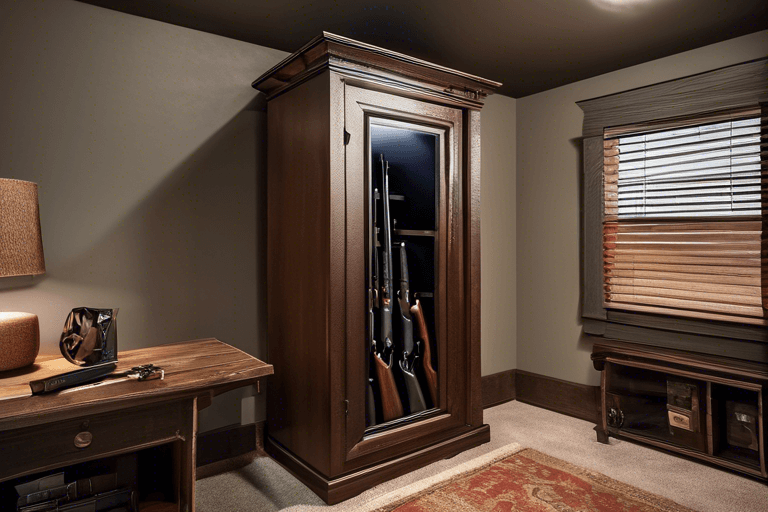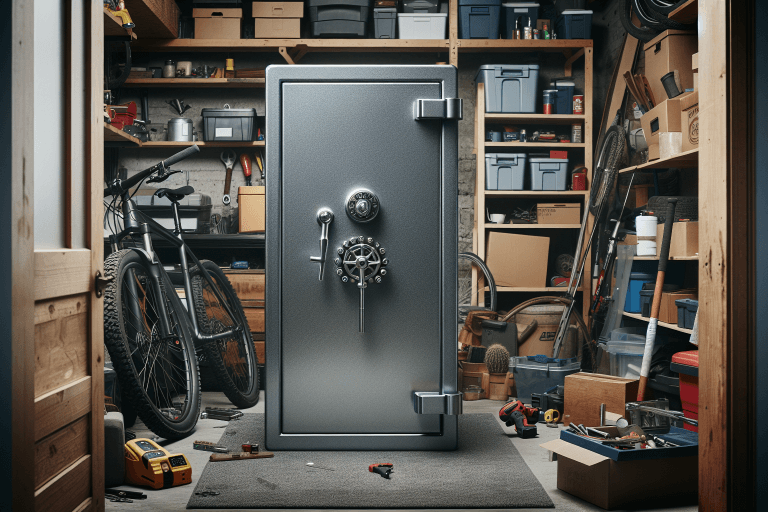
Can You Keep a Gun Safe in the Garage?
Table of Contents
- Key Takeaways
- The Garage Dilemma: Pros and Cons of Storing a Gun Safe in the Garage
- Preparing Your Garage for a Gun Safe
- Tackling Temperature Fluctuations and Humidity
- Enhancing Security Measures for Garage Gun Safes
- Creative Concealment: Hiding Your Gun Safe in the Garage
- Alternative Locations for Gun Safes
- Best Practices for Storing Firearms in a Garage Gun Safe
- Summary
- Frequently Asked Questions
Can you keep a gun safe in the garage? Yes, with thoughtful preparation and specific adjustments.
In this guide, we reveal the key steps to securely and effectively accommodate your gun safe in the garage, from addressing environmental challenges to amplifying security.
Learn how to safeguard your firearms against potential hazards right where you park your car.
Key Takeaways
Storing a gun safe in the garage poses risks such as moisture-related damage and increased vulnerability to break-ins; careful planning, adequate ventilation, lighting, and security enhancements are critical to address these issues.
Temperature fluctuations and humidity in the garage require management through insulation, heating solutions, dehumidifiers, and dessicants to create a stable and safe environment for firearm storage.
Enhanced security for a garage gun safe includes anchoring the safe, installing surveillance and alarm systems, implementing advanced locking mechanisms, and employing creative concealment tactics to reduce visibility.
The Garage Dilemma: Pros and Cons of Storing a Gun Safe in the Garage
Given its spacious nature, the unheated garage initially appears to be an ideal choice for a gun safe, as it offers abundant room, even for larger safes. Yet, it’s not all smooth sailing.
The garage comes with its set of challenges. Chief among these is the risk of moisture-related damage to firearms and ammunition caused by condensation, a common occurrence in garages due to their frequent lack of climate control.
Another concern is security. Despite their many conveniences, garages are generally more prone to break-ins compared to the main house. This susceptibility to break-ins underscores the importance of robust security measures for your garage-based gun safe.
Clearly, while a garage can be a suitable location for your gun safe, careful planning and preparation are paramount.
Preparing Your Garage for a Gun Safe
There are several steps to consider before installing your gun safe in the garage, that will boost safety and render the environment suitable for firearm storage.
Let’s delve into these aspects, from clearing clutter and improving ventilation and lighting, to securing the area.
Clearing Clutter
Garage clutter isn’t merely an eyesore; it can pose safety risks and impede access to your gun safe. A cluttered environment can result in increased humidity levels, potentially causing condensation within the safe and leading to rust or corrosion of firearms.
Clutter can make it challenging to access your gun safe promptly when necessary. Therefore, maintaining an organized, clutter-free space is essential.
This can be achieved through effective garage organization techniques such as disposing of obvious trash, grouping like items together, and using storage solutions to keep the area tidy.
Ventilation and Lighting
Maintaining optimal conditions for your gun safe requires adequate ventilation and lighting in the garage.
Adequate airflow prevents the buildup of moisture, which can lead to rust and damage to firearms. Enhancing ventilation can be achieved by installing vents or fans, or simply opening windows or doors for natural airflow, ensuring fresh air inside the gun safe.
As for lighting, LED safe lights are specifically designed for gun safes, offering clear visibility and enhancing safety.
Securing the Area
Securing the garage is a critical step in preparing it for a gun safe. This involves not only securing the safe itself but also the surrounding area. Here are some effective ways to secure your gun safe:
Bolt it to a cement surface using heavy-duty anchors or bolts
Ensure proper lighting in the garage
Ensure the door of the garage is adequately secure
Consider keeping the safe itself out of sight to deter potential thieves
By implementing these security measures, you can ensure the safety and protection of your gun safe and its contents.
To enhance window security, consider installing permanent bars or using zip ties to secure the emergency door release. Motion sensor lights can also boost security by discouraging intruders and improving overall safety.
Tackling Temperature Fluctuations and Humidity
After preparing your garage, the next hurdle to overcome is managing climate conditions, particularly temperature variations and humidity.
In this section, we’ll explore how to manage these factors using insulation and heating solutions, dehumidifiers and desiccants, and regular maintenance checks.
Insulation and Heating Solutions
Insulating your garage and employing heating solutions can help maintain a stable temperature, which is important for gun storage.
Rigid foam board or blocks of wood can effectively prevent condensation by elevating the safe from the concrete floor.
Meanwhile, to control humidity inside and maintain the ideal temperature, heating solutions such as silica gel, dessicant packs, rechargeable dehumidifiers, or small fan forced electric heaters with a heating element can help maintain a stable temperature within the safe, while anti corrosion vapor emitters protect against rust and corrosion.
Dehumidifiers and Desiccants
Controlling relative humidity is another crucial aspect of maintaining optimal conditions for your gun safe. High humidity can lead to rust and corrosion, impacting the performance of firearms.
Dehumidifiers and desiccants can be used to regulate moisture levels effectively.
A plug-in dehumidifier, which measures relative humidity, is a straightforward and efficient approach to reducing excessive humidity, protecting the interior of your gun safe from moisture.
Regular Maintenance Checks
Conducting regular maintenance checks on your gun safe is essential to ensure the optimal storage conditions for your firearms.
Regular inspections for signs of wear or damage, including checking locking mechanisms, door seals, and all other components, should be conducted every one to four years.
Enhancing Security Measures for Garage Gun Safes
In addition to preparing the garage and managing climate conditions, it’s vital to bolster security measures for your garage gun safe, especially near the garage door.
This includes anchoring the safe, installing surveillance and alarm systems, and implementing advanced locking mechanisms.
Anchoring the Safe
Anchoring your gun safe securely is an essential security measure. By fastening the safe to a concrete surface using heavy-duty anchors or bolts, you can prevent the safe from tipping over and increase its resistance to theft.
Careful planning and attention to detail are crucial to avoid common errors such as using the incorrect type of anchors or leaving tools in the garage that could facilitate unauthorized access.
Surveillance and Alarm Systems
Surveillance cameras and alarm systems are other effective security measures for monitoring your garage gun safe.
High-quality video feed, sufficient coverage area, and ease of installation should be prioritized when selecting a surveillance system.
Alarm systems, on the other hand, can integrate with other measures such as motion detectors to establish a comprehensive security system.
Advanced Locking Mechanisms
Finally, advanced locking mechanisms provide an additional layer of security for your gun safe. These include electronic locks and biometric locks that employ state-of-the-art technology to improve security and provide faster access.
However, as with any technology, these may come with higher costs and potential technical issues, so careful consideration is necessary.
Creative Concealment: Hiding Your Gun Safe in the Garage
Besides implementing security measures, inventively concealing your gun safe can offer an extra layer of protection by making it less conspicuous.
Let’s explore how custom cabinets and furniture, hidden compartments, and camouflage techniques can help you hide your gun safe in plain sight.
Custom Cabinets and Furniture
Custom cabinets and furniture can be used to disguise a gun safe, making it blend seamlessly with your garage environment.
This is harder with gun safes compared to regular safes but can be achieved by creating a piece of furniture such as a large armoire, bookcase, or a mock refrigerator to house the safe within.
Numerous pre-made concealment furniture options are available in the market for those who prefer ready-made solutions.
Hidden Compartments and Wall Installation
Another effective way to put a gun safe is by creating hidden compartments in cabinets or installing the safe itself within a wall. These discreet storage options provide hidden storage for your firearms while maintaining convenient access.
Camouflage Techniques
Camouflage techniques can further diminish the visibility of your gun safe. Some techniques to consider include:
Applying paint that matches your garage walls
Affixing decals that blend with the surrounding environment
Using a fabric gun safe cover to effectively disguise your safe
These techniques can make your gun safe blend into its surroundings.
Alternative Locations for Gun Safes
Although the garage may serve as a suitable location for a gun safe, it isn’t the sole option.
Alternative locations such as basements, closets, and under-the-bed spaces can also be considered.
Let’s delve into the advantages and considerations of these alternatives, which involve a considerable amount of factors to assess.
Basements and Storage Rooms
Basements and storage rooms provide a secure location for your gun safe due to their less visible and cooler environment. However, these areas may have moisture problems, hence the need for dehumidifiers or small, energy-efficient heating elements to regulate humidity levels.
The installation of a gun safe in the basement also requires careful planning, such as installing the safe on a raised platform to protect against any flooding risk.
Closets and Hidden Spaces
Closets and hidden spaces also offer a secure and discreet location for your gun safe. These spaces allow for easy accessibility while keeping the safe out of sight.
When selecting a gun safe for a closet, consider one that is specifically engineered to fit within standard-sized closets for efficient use of space.
However, remember that burglars often search closets for safes, so additional security measures may be necessary.
Under-the-Bed and Bedside Safes
Under-the-bed and bedside safes provide quick accessibility in case of emergencies. These safes can be strategically positioned for easy access while ensuring the security and protection of the firearms, but they may provide limited space for your entire gun collection.
It is possible to put a gun safe upstairs or on a second-story floor but important factors need to be taken into consideration and professional help is recommended.
Best Practices for Storing Firearms in a Garage Gun Safe
Having covered preparation, climate management, security measures, and potential safe locations, we can now examine best practices for storing firearms in a garage gun safe.
We will discuss key tips for firearm maintenance, ammunition storage, and safe organization.
Firearm Maintenance
Regular firearm maintenance is important to prevent damage and ensure proper functioning. Firearms should be cleaned after use or exposure to moisture, dirt, or sweaty hands.
Furthermore, regular inspections every two or three months are recommended to assess for any signs of corrosion.
Ammunition Storage
Proper ammunition storage is just as important as firearm maintenance. It’s crucial to store ammunition in airtight containers and at room temperature with low humidity to prevent rusting and damage.
Remember, safety is paramount. Ammunition should be stored separately from firearms in secure locations.
Organizing Your Safe
Lastly, organizing your gun safe can significantly enhance its utility. Efficient arrangement of your gun safe involves sorting guns by type, using gun safe organizers, and using gun racks and rifle rods for long guns.
This not only maximizes the space within the safe but also ensures easy access to your firearms when necessary.
Summary
In conclusion, careful consideration and planning are essential when choosing to store a gun safe in the garage.
From preparing the garage and managing climate conditions to enhancing security measures and creatively concealing the safe, each step contributes to the overall safety and accessibility of your firearms.
With the right steps, a garage gun safe can indeed be a viable, secure, and convenient option for firearm storage.
Frequently Asked Questions
Can I keep my gun safe in an unheated garage?
Yes, you can keep your gun safe in an unheated garage as long as you control the humidity and take necessary precautions, such as using silica gel and bolting the safe to the cement.
What temperature should a gun safe be in a garage?
To protect your firearms from rust, keep your gun safe at around 70°F in the garage, as humidity from frigid weather can be damaging.
Where not to put a gun safe?
Avoid putting a gun safe in an upstairs bedroom or master bedroom since these areas are often the first target for criminals searching for valuables.
How should I prepare my garage for a gun safe?
Prepare your garage for a gun safe by clearing clutter, enhancing ventilation and lighting, and securing the safe to a concrete surface using heavy-duty anchors or bolts. This will help ensure the safety and security of your firearms.
How can I enhance the security of my garage gun safe?
To enhance the security of your garage gun safe, anchor it to the floor, install surveillance and alarm systems, and use advanced locking mechanisms such as electronic or biometric locks.

